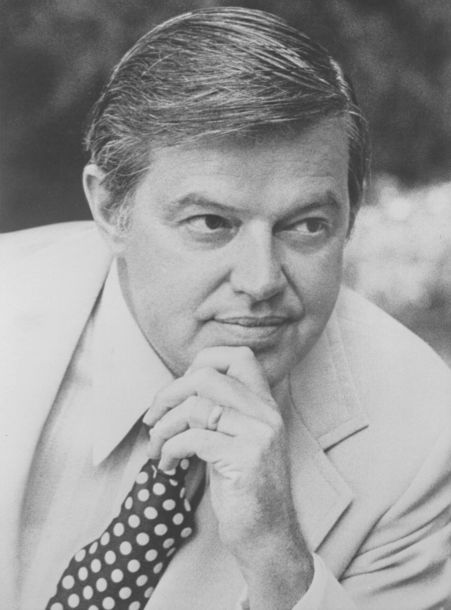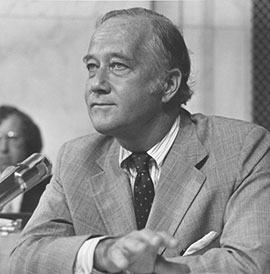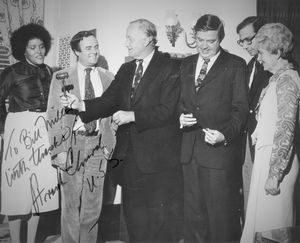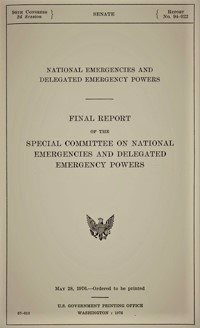![]()
Senator Frank Church (D-ID), a long-time defender of congressional checks and balances, was a logical choice to co-chair the Special Committee on the Termination of the National Emergency.
U.S. Senate Historical Office

Senator Frank Church (D-ID), a long-time defender of congressional checks and balances, was a logical choice to co-chair the Special Committee on the Termination of the National Emergency.
In 1973 the Senate assigned a herculean task to a small temporary committee. The Special Committee on the Termination of the National Emergency (renamed the Special Committee on National Emergencies and Delegated Emergency Powers in 1974), co-chaired by Democrat Frank Church of Idaho and Republican Charles Mathias of Maryland, would investigate outdated emergency powers granted to presidents by Congress in the previous half century. The inquiry’s surprising findings convinced Congress to pass the National Emergencies Act of 1976.
The story of this obscure Senate committee begins with the Vietnam War. In 1968 Republican presidential candidate Richard Nixon pledged to end the war if elected. In the spring of 1970, however, President Nixon secretly expanded the war into Cambodia—without congressional approval. Weeks later, Nixon announced the expansion of the war into Cambodia on national television. The administration’s actions infuriated many senators, especially Frank Church, a long-time Vietnam War critic. Church drafted a proposal—later known as the Cooper-Church amendment—to prevent congressionally appropriated funds from being used in Cambodia. Secretary of Defense Melvin Laird quickly rendered this effort moot. If Congress halted funding for the Cambodia effort, Laird warned, the Pentagon would fund the operation under the emergency provisions of a Civil War-era law called the Feed and Forage Act. With that law, Congress had granted the U.S. Cavalry the authority to purchase feed for its horses if previously appropriated money had run out while Congress was not in session. Laird explained that the provision had been used in 1958 in Lebanon and in 1961 in Berlin to fund U.S. military actions. 1

Senator Charles Mathias (R-MD) first proposed a committee to investigate national emergency powers in 1971.
U.S. Senate Historical Office

Senator Charles Mathias (R-MD) first proposed a committee to investigate national emergency powers in 1971.
The administration’s ability to circumvent Congress under the authority of a century-old law troubled Church. He had developed a reputation among his colleagues as a checks and balances proselytizer, routinely sermonizing that growing executive power threatened the health of constitutional government. When Nixon’s predecessor, Democrat Lyndon Johnson, occupied the White House, Democratic majorities in Congress felt little urgency to limit the powers of a president of their own party, and Church’s homilies fell on deaf ears, but the Nixon administration’s invasion of Cambodia converted some of Church’s colleagues to his cause. One of them, Republican Charles “Mac” Mathias of Maryland, insisted that Congress had a role to play in holding every president accountable—regardless of party. On January 6, 1973, the Senate created the Special Committee on the Termination of the National Emergency. Church and Mathias would lead the inquiry, joined by six colleagues and a small committee staff.
 Special Committee on the Termination of the National Emergency, pictured with committee staff, 1973" />
Special Committee on the Termination of the National Emergency, pictured with committee staff, 1973" />
Co-chairs Charles Mathias and Frank Church, surrounded by committee staff, examine their identical gavels, symbols of their equal power as co-chairs.
Charles Mathias (R-MD) and Frank Church (D-ID), Co-chairs of the Senate Special Committee on the Termination of the National Emergency, Pictured with Committee Staff, 1973

Co-chairs Charles Mathias and Frank Church, surrounded by committee staff, examine their identical gavels, symbols of their equal power as co-chairs.
Identifying the powers that Congress had conferred on presidents during times of emergency proved to be a complex task. In the pre-personal computer era, searching hundreds of printed government publications for delegated emergency powers was extraordinarily time-consuming. After months of digging, committee staff learned that the U.S. Air Force maintained a searchable list of statutes on a computer in Colorado. Using that database and other published paper sources, investigators painstakingly compiled a list of 470 powers that Congress had granted to presidents in the previous 50 years during times of crisis, such as depression or war. “Taken together, these hundreds of statutes clothe the president with virtually unlimited power with which he can affect the lives of American citizens in a host of all-encompassing ways,” Church wrote, including seizing property and commodities, instituting martial law, and controlling transportation and communication. Though these crises had ended, Congress had not officially cancelled or revoked the powers it had granted to administrations to address them. As the Nixon administration had demonstrated, presidents could exercise these powers without congressional approval. Four national emergencies remained in effect—including one on the books since 1933! “It may be news to most Americans,” explained one Washington Post reporter, that “we have been living for at least 40 years under a state of emergency rule.” 2
 Final Report of the Senate Special Committee on National Emergencies and Delegated Emergency Powers, 1976" />
Final Report of the Senate Special Committee on National Emergencies and Delegated Emergency Powers, 1976" />
The committee published its final report in 1976 documenting the need for the National Emergencies Act, which became law on September 14, 1976.
Final Report of the Senate Special Committee on National Emergencies and Delegated Emergency Powers, 1976

The committee published its final report in 1976 documenting the need for the National Emergencies Act, which became law on September 14, 1976.
The committee’s investigation found that the legislative branch had rarely limited presidents’ emergency powers. The judicial branch, by contrast, had occasionally constrained those powers. For example, the Supreme Court firmly rebuffed President Harry Truman during the Korean War. The president had issued an executive order to seize control of some steel mills in 1952. Truman insisted that, as commander in chief, he had the authority to take action to avoid steel production slowdowns likely to be caused by an anticipated labor strike. The Court’s landmark decision in Youngstown Sheet & Tube Company v. Sawyer found that no law provided for the president to seize control of private property. Associate Justice Robert Jackson wrote that presidents enjoyed maximum power when they worked under the express or implied authority of Congress, but presidents who took steps explicitly at odds with the wishes of Congress worked “at [the] lowest ebb” of their constitutional power. 3
The committee’s exhaustive research as well as several high-profile congressional investigations, including the Senate Watergate inquiry of 1973–74, convinced many in Congress that the time had come to reassert congressional checks and balances. The House introduced the National Emergencies Act in 1975 and the Senate passed a slightly amended version of that bill by voice vote in August 1976. The House agreed to the Senate’s amended bill, and President Gerald Ford signed the National Emergencies Act into law on September 14, 1976. The new law ended four existing states of emergency and instituted accountability and reporting requirements for future emergencies. 4
1. Frank Church, “Ending Emergency Government,” American Bar Association Journal 63 (February 1977): 197–99.
2. “Bill Miller, Staff Director, Church Committee," Oral History Interview, May 5, 2014, Senate Historical Office, Washington, D.C.; Church, “Ending Emergency Government,” 197–99; Ronald Goldfarb, “The Permanent State of Emergency,” Washington Post, January 6, 1974, B1; Special Committee on the Termination of the National Emergency, Emergency Powers Statutes: Provisions of Federal Law Now in Effect Delegating to the Executive Extraordinary Authority in Time of National Emergency, S. Rep. 93-549, 93rd Cong., 1st sess., November 19, 1973.
3. "Youngstown Sheet & Tube Company v. Sawyer," Oyez, accessed June 16, 2021, https://www.oyez.org/cases/1940-1955/343us579.
4. “Major Congressional Action: National Emergencies,” Congressional Quarterly Almanac 32 (Washington: Congressional Quarterly, 1976): 521–22.